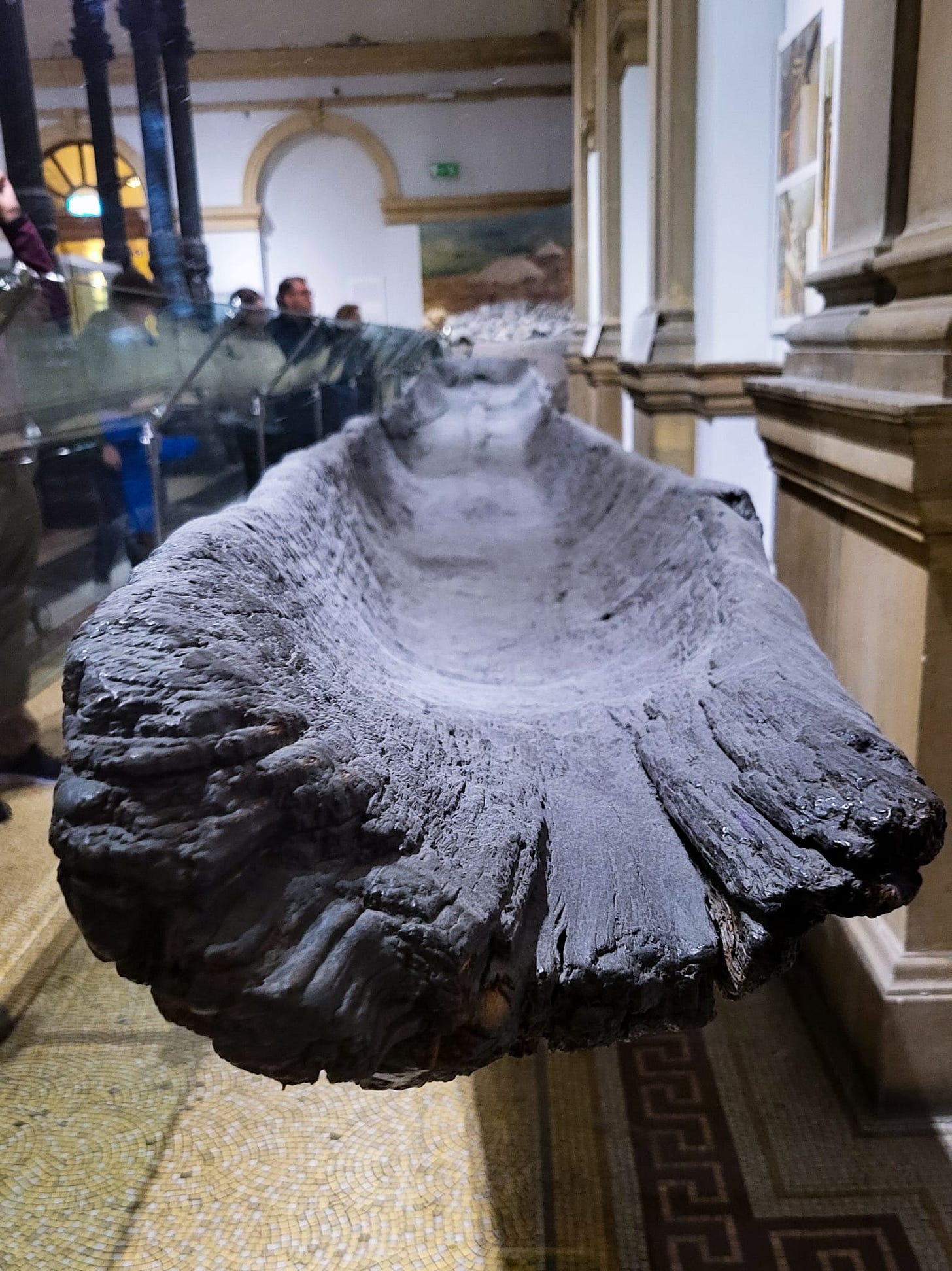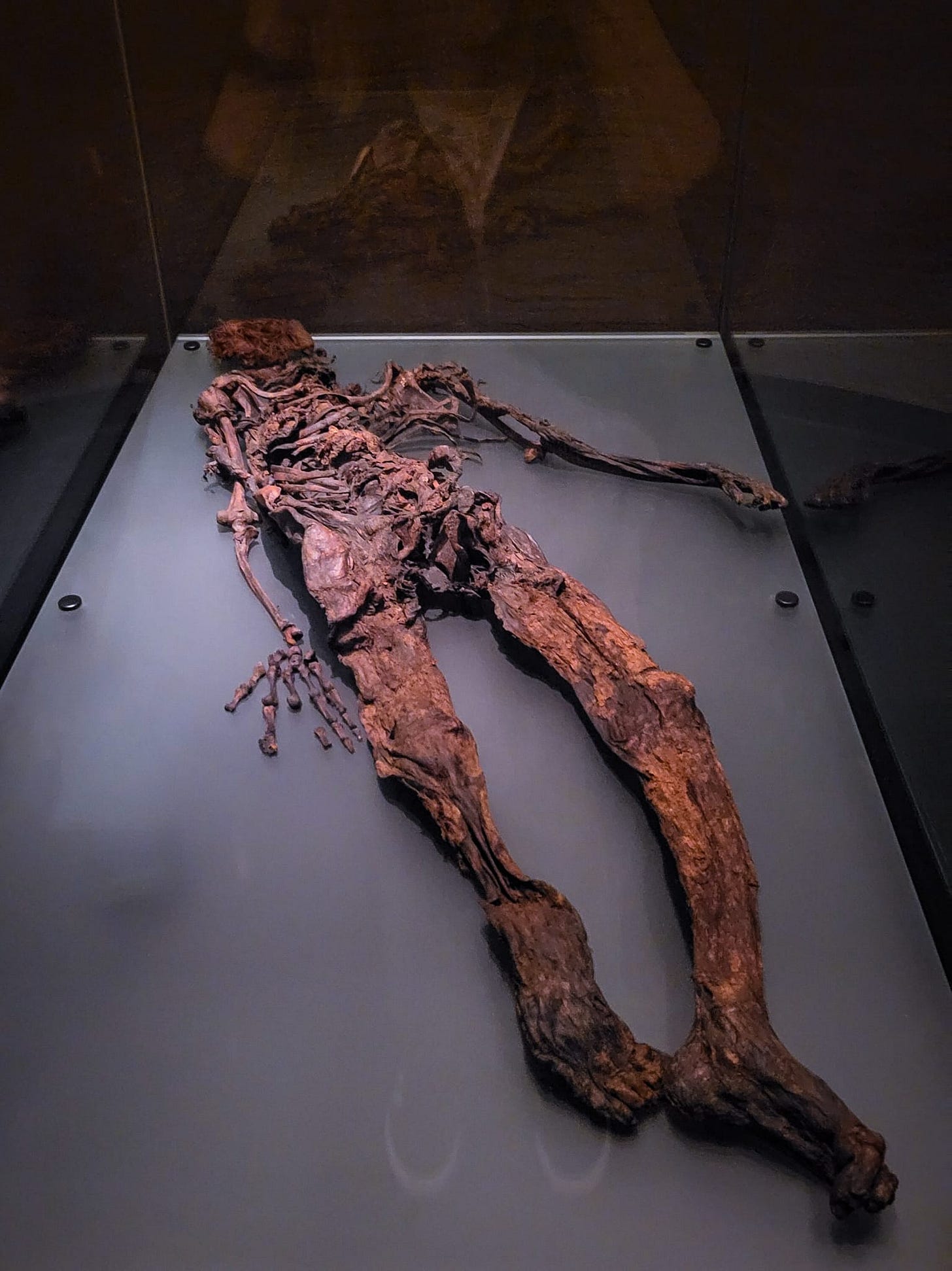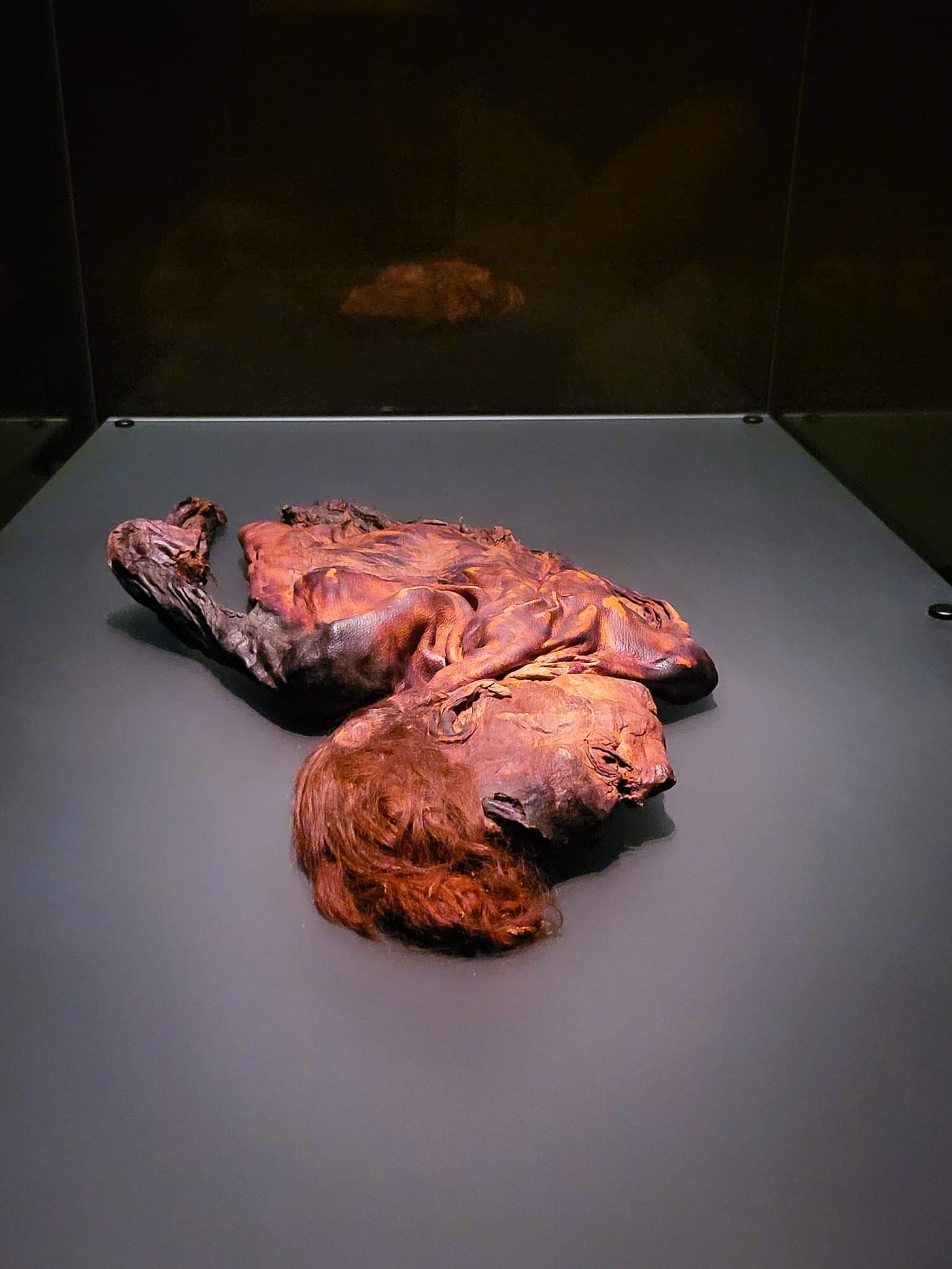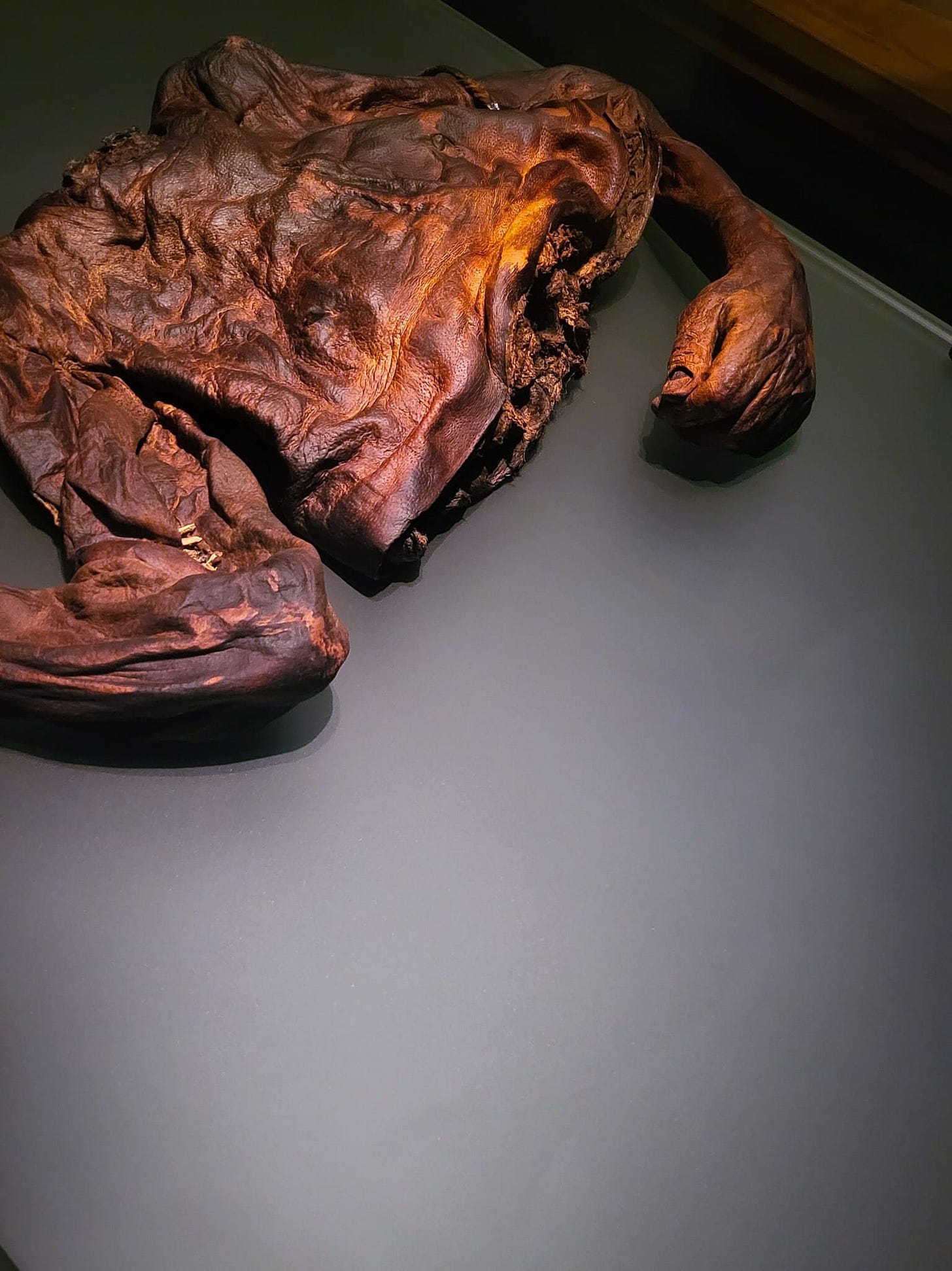Revisiting the bog bodies
An autumn equinox grounding at the National Museum of Archaeology.
This weekend marks the shift in the year to shorter days and longer nights. The autumn equinox, a time of balance between light and dark. This weekend also marks my fifth anniversary of moving back to Dublin. Both occasions have given pause for reflection and a little grounding. What better place, on a weekend of pagan significance, to get grounded than the National Museum of Archaeology.
The museum is one of the places which stands out in my childhood map of Dublin but I can’t remember if I’ve ever ventured in there as an adult. Coming at it with a fresh eye and my writer’s appetite to scavenge for material, I kept the notes on my phone open. Please enjoy the stream of consciousness which followed.
Time to get grounded, looking at rocks. Nothing makes you question the progress of evolution more than looking at a flint axehead and thinking ‘ooo that looks like it would be a good weight to hold in your pocket’. Is that an ancestral thing, she wonders as someone who carries conkers in coat pockets from one season to the next, the need to gather and carry things of potential future use, or is it something darker? The comfort of having a heavy stone to hand when facing modern day threats - emails and unexpected phone calls.
Stone picks. Flint blades. Bann flakes which look like leaves. Polished stone spearheads which could pass as samples for kitchen worktops - what we once used to kill our food now serves as a sanitised altar upon which our food is unpacked from plastic.
Passage tombs conjure up memories from a school visit to Knowth. A thin place. This weekend feels like a thin place, the shift of light and dark, a touchstone from which to look back and ahead.
Imagine being the person who discovered the Lurgan Longboat. Imagine toiling away on your stretch of bog, either rain-soaked or sweating because you are always one of the other on a bog, and finding something immovable at the end of your spade. What was the moment like when they realised the scale of what was underfoot? When did frustrated inconvenience awaken into stunned realisation. A fucking longboat.
The debris of the domestic is always my favourite. Spearheads and axe heads are all very important but I want to see the shouldered bowls, the little piles of periwinkle shells, the shell necklaces discovered at a burial site in the Phoenix Park. It’s the place names that make this kind of history real - knowing these relics were discovered beneath the ground you now run 10ks on (theoretically) or drive around in the dark for practice -driving, not dogging (literally). Our ancestors from this time carved and decorated bowls for the burial sites but not those in everyday use, the ones they handled and look at everyday. Were we such a utilitarian lot back then?
The maceheads and stones are unfathomable - that such perfectly circular things could be crafted by hand and not machine. These suggest less utilitarianism. There is a sense of pride and perfection which feels much more like us.
Speaking of us. A people. A once pagan lot. It is time to visit the Bog Bodies.
The darkest pagan shadows. Territorial inaugurations. Ritual killings. Sacrifice. Offerings to fertility deities to mark a king’s marriage to the territorial earth goddesses. Human blood fertilising land. Sacrifices made at this turn of the year, at Lunasa, a time of heady celebration when joyous fervour could tip over into threat, hedonism which could result in someone losing their head. Echoes of Sarah Moss’ brilliant Ghostwall. Perhaps there was an element of ominous portent in these killings - reminding kings of their responsibility to their people. Spilling blood to make blood all the more precious, all the more real. Vulnerable. In need of protection. And good sense. Sound judgement.
Perhaps.
But also it was just mindless superstition - “swear by the gods by whom my people swear”. There is a Corlea figure - an anthropomorphic boundary marker. That’s more the thing. Spirit animals carved in native wood, marking the play areas of overgrown boys in crowns of twisted boughs, ruling over their tuath. Tuath - the smallest territorial unit to be ruled by a petty king.
There is a map of bog treasures on the wall. Relics discovered by children and turf cutters and those who shouldn’t be poking about. Spearheads, bog butter, pendants, axe heads, wooden yokes, rotary querns, saddle querns, wooden wheels, bog bodies, human skulls. Imagine being the turf cutter who discovered a human skull?
The bog body of Baronstown West.
Feet shrivelled. Toes curled in, as if in cold or fear. Legs like cardboard, or tea-soaked paper. How narrow his bones - barely a difference between finger and forearm. Ribs broken into pieces, a cage caved in on itself. They look like reeds which could be coaxed to lift and sway under a current. The scalping of rusted hair. Were they all ginger or does the bog oxidise the pigment? The hair is thick. Healthy looking. The hands are clasped. Copying the grip you can imagine the dread of the blow they knew was coming. It is a grip of anticipation. Hip bones, pelvis, remain standing, a permanent fixture. Sturdy. Yet we break them in childbirth.
The first glimpse of AD on the information plaques. The creeping in of metal, agricultural tools, how stark the sight of gold appears after so much stone and clay. How batshit people must have been over the first sight of gold. The sheer audacity of it - molten sunshine twisted in intricacies around someone’s neck after a whole life of bog cotton and the earthy tones of heather.
The bog body of Clonycavan.
Half a man. The same rusted scalp of thick hair. A face, most definitely. An ear. A nose. An eye socket. As if you could gently press against the flesh to mould it back into recognition - a neighbour, a second cousin, ah John, it’s yourself. The leathered skin of his torso. There is a modern violence to this. His bottom half ripped away, shredded by machines. A man immobilised in the afterlife, the indignity of it. Still, the colours are beautiful.
They have fixed bog wood at the threshold of each modern tomb. Soft black bones, gleaming, majestic. Art I’d pay a lot of money for. Bog wood. Uncarved, unearthed, a totem to stand in the wilderness of my someday garden.
There is a list on the wall of the scientific examinations and tests that the bog bodies were subjected to. How foreign to them. How utterly removed from their existence. The tools which were used to uncover their remains might not have shocked them, they might have traced the thread from their own flint axe heads to modern day metals. But the white rooms, the MRI scanners, that would have blown their minds.
To have handled those leathered bodies. To have scraped away the dirt from the definition of their fingernails. To have held a scalpel in hand and hovered at the tendrils of what was once the basket of a man’s chest.
The bog body of Oldcroghan.
Science has told the story of this man. They believe he was 25 years old, was 6 foot 3, of strong build once. Now reduced to torso. And yet, you could almost picture that chest rising and falling as it fills and empties of air. It is barely half a body, yet it is almost the easiest to draw into something whole. Something jars about the placement of the arm and hand, bent below the chest, where his trunk should be, the soft skin of his stomach. His hands are so perfectly preserved, fingernails and knuckles. There is a weight to this half a man. A sturdiness. The years and bog have not robbed him of that.
Elsewhere, a leather shield, found upright in the bog. A wooden sword. Spearbutts and a spearhead with a hole, like a hagstone. These feel more ritualistic, like toys.
The bog body of Gallagh.
Found with a cape tied around the neck. Strangled they believe. The body on it’s side. The indent of wooden stakes embedded in the memory of his body. Arms crossed. Somehow this one brings home the violence. He is less at peace. He was the earliest discovered, the most damaged. He is not so leathered, more paper. There is a greater vulnerability. He could crumble into dust. Feet tangled up in themselves. Bones turned to wrapping. Skull caved in. The intricate mechanics of his elbow. Empty sockets once home to teeth. A rippled ribcage under paper.
Elsewhere there are the faces of man and beast carved into a replica church doorway from County Clare. Equal billings. Elsewhere, Italian jadeitite axe heads discovered in Mayo, Westmeath and Donegal from 4000 BC, unworn by use. Ceremonial. Symbolic. The earliest example of notions.
The growth of metalwork and mining. Coldhammered from pure copper and gold. Before casting and complex tools and designs. Pottery and wooden bowls. Jet buttons. Copper blades. Decorated stones. Swirls and circles. The warmth of bronze. Of the bronze age.
Early bronze age burials - short rectangular graves - pits with end stones and paved floors for cremated remains. Efficient. Sustainable.
The Irish language on the plaques continues to draw my eye, its presence is heavier here. Words that were carved in the same land as these urns and bowls.
Megalithic tombs. Stone circles. Ritual. There are stones and shells places in plant pots on my balcony at home. There are standing stones in a glass bowl of soil and succulents. A terrarium next to a record player, echoes of megalithic.
The mid to late bronze age saw climatic deterioration, widespread change. Post and wattle construction. Earthen banks. Stone walls. Settlements on small islands and lake edges. The mass production of weapons. Familiar.
I trace the evolution of decorative sunflower pins through clay and bronze and gold. We learn to have nice things - amber necklaces, horsehair tassels. We play music. Horns, the oldest known instrument, like didgeridoos.
As history turns to gold I grow distracted. I am more taken in by people. A father with two daughters. One looks at the piles of gold behind glass, ponders if this is why gold is so expensive, because so much of it is here, hidden behind glass. Her father confirms, it is a limited resource, it’s thought that all the world’s gold could fit within two swimmings pools. Behind them, an elderly man places his hands on his wife’s shoulders in a gentle side hug, as if they were looking through a jeweller’s window, picking a ring.
Twisted gold torc. Spirals. Flattened gold fashioned into earrings and pendants and bracelets and hair ties. Like tinfoil, a woman says.
The burying and hoarding of gold in bogs. Safekeeping. Offerings. Loss. Preservation.
A turn into a side room brings a brutal thud of Christianity. More superstition. And my attention gives way entirely to the rumbling of my stomach. Chalices and broaches and the like are fine and pretty but I am hungry.
Before I give in, I explore the discoveries at a bog at Faddan. A book. A biblical text. Discovered by turf cutters who immediately recognised its significance and reburied it until the experts arrived. On a set of tablets, wrapped in animal hide for protection, the experts identified the hands of two separate writers - one master, one student.
By the 6th century AD, Ireland’s scholars had established a distinctive writing style. Students came from Britain and the continent. Ogham script standing stones travelled too, discovered across England, Scotland and Wales. The movement of people is nothing new. Religion cemented crafts, skills, gave cause for education, literacy. The craft of preparing vellum from calfskin, ink from carbon and oak galls. We had an industry.
“Christianity is a religion of the book.” Superstition. Fiction. Stories.
The same family from before, father and daughters, joined now by a mother and a smallest girl, no more than a tot, too small to see the exhibits. Her eldest sister picks her up, shows her the ancient book. “What do you think they wrote about back then?” She asks. The little girl looks at the ancient pages, the scores of colour and ink. Her words are crumbled, a tongue still learning the correct shapes but she knows the answer. “Magic”, she replies.





